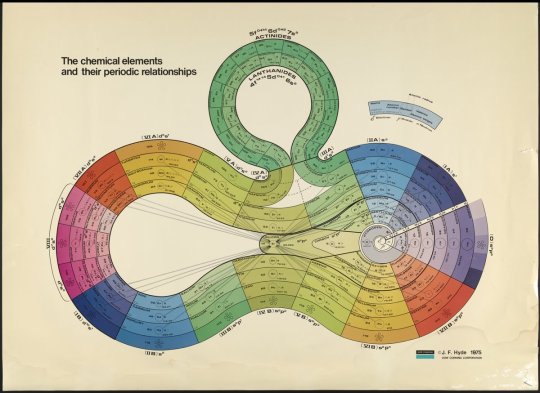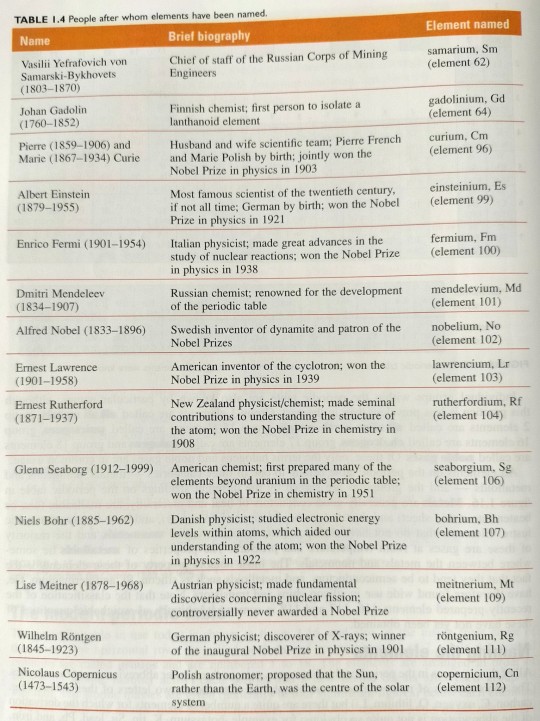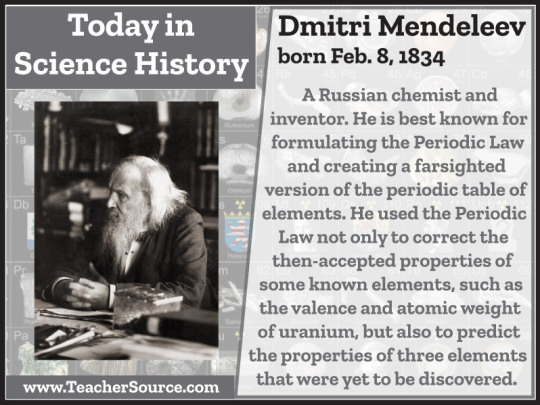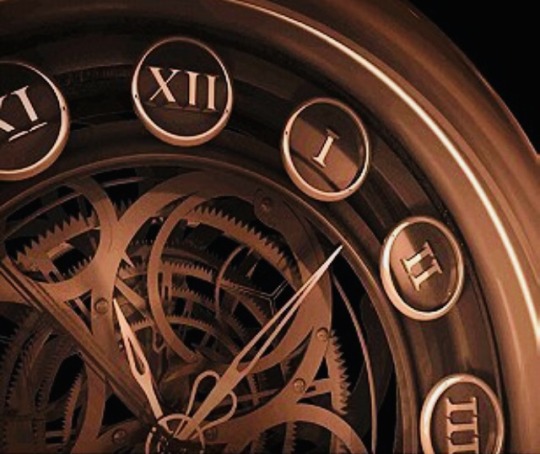#Dmitri mendeleev
Text

February 8th is Dmitri Mendeleev's birthday
Mendeleev was a Russian chemist and inventor. He is best known for formulating the Periodic Law and creating a version of the periodic table of elements.
Shown here is a rainbow-colored periodic table in the style of a spiral with different sizes of revolutions designed by J.F. Hyde of the Dow Corning Corporation.
Image: Hyde, J.F. “The Chemical Elements and Their Periodic Relationships.” Dow Corning Corporation, 1975. Folder Flat File 2. Science History Institute. Philadelphia.
#mendeleev#Dmitri mendeleev#periodic table#happy birthday#chemistry#periodic law#digital collections#othmeralia
246 notes
·
View notes
Quote
There is nothing in this world that I fear to say.
Dmitri Mendeleev
74 notes
·
View notes
Text
RIP Dmitri Mendeleev you would've loved excel
6 notes
·
View notes
Quote
There is nothing in this world that I fear to say.
Dmitri Mendeleev
#Dmitri Mendeleev#quotelr#World# Fear# nothing#quotes#literature#life quotes#author quotes#prose#lit#spilled ink#writers on tumblr#writing inspiration#poets on tumblr
12 notes
·
View notes
Text

“Like his Russian contemporary Dostoevsky — who wrote his entire novel 'The Gambler' in three weeks to pay off desperate gambling debts — Mendeleev threw together his first table to meet a textbook publisher's deadline.”
Sam Kean, 'The Disappearing Spoon' - the quote, as well as the image.
#booklr#book quote#the gambler#fyodor dostoevsky#dmitri mendeleev#mendeleev#periodic table#literature quotes#quotes#currently reading#books and reading#books and literature#sam kean#the disappearing spoon#books and libraries#literature#lit#periodic table of elements#science#book blog#books#book#reading#book recommendation#dostoevsky#gambling#deadline#book quotes
15 notes
·
View notes
Text
I blame my middle school obsession with Dmitri Mendeleev for the fact that even now, in college, whenever I make flashcards for studying chemistry, I can’t help but think about him and his element cards.
3 notes
·
View notes
Text
Ideas for future episodes of “Epic Rap Battles of History”:
1) Manuel Noriega vs. Saddam Hussein (theme: dictators who were taken down by the United States)
2) Steven Seagal vs. Ip Man (theme: martial arts fraud against one of the greatest of all-time. Think of this as a spiritual sequel to Lance Armstrong vs. Babe Ruth)
3) Jordan Belfort vs. Charles Ponzi (theme: two of the most infamous con artists who ever lived)
4) Joel Miller and Ellie Williams vs. Jean Valjean and Cosette (theme: fictional traumatized father figures and their daughter figures)
5) Avatar Aang vs. Dmitri Mendeleev (theme: master of the four elements against the founder of the periodic table of elements)
6) Hiawatha vs. Sitting Bull (theme: two of the most well-known Native American leaders)
7) Mary Wollstonecraft vs. Ruth Bader Ginsburg (theme: two of the most well-known feminist icons)
8) Buck Rogers vs. Flash Gordon (theme: the original sci-fi heroes)
#epic rap battles of history#erb#manuel noriega#saddam hussein#steven seagal#ip man#jordan belfort#Charles ponzi#joel miller#ellie williams#jean valjean#cosette#Aang#dmitri mendeleev#hiawatha#sitting bull#mary wollstonecraft#ruth bader ginsburg#buck rogers#flash gordon#youtube
6 notes
·
View notes
Text
Surprisingly few elements have been named after people; at present, only 15 people have been immortalised on the periodic table, and they are listed in table 1.4.

"Chemistry" 2e - Blackman, A., Bottle, S., Schmid, S., Mocerino, M., Wille, U.
#book quotes#chemistry#nonfiction#textbook#eponym#vasilii yefrafovich samarski bykhovets#samarium#johan gadolin#gadolinium#pierre curie#marie curie#curium#albert einstein#enrico fermi#fermium#dmitri mendeleev#mendelevium#alfred nobel#ernest lawrence#lawrencium#ernest rutherford#rutherfordium#glenn seaborg#seaborgium#niels bohr#bohrium#lise meitner#meitnerium#wilhelm rontgen#nicolaus copernicus
6 notes
·
View notes
Text
For most of the history of civilisation we’ve exploited a pretty small selection of metals, including copper and tin for bronze-age tools, iron for steel, and lead, gold and silver. Our repertoire has begun to diversify over the past century or so, with the widespread use of aluminium and other new metals. But in the past few decades the number of different metals we wield in our technological society has absolutely exploded. A modern smartphone contains more than 30 different elements. These include carbon and hydrogen in the plastic casing, silicon for the microchip wafers, and copper wiring and gold contacts. But there are also small amounts of a large number of other metals, each exploited for its own particular electronic properties, or for the tiny, powerful magnets used in the speaker and vibration motor. This means that if you own a smartphone, you have in your pocket a substantial fraction of all the stable elements of the periodic table. And it’s not just modern electronics that demand a huge diversity of different metals. So too do the high-performance alloys used in the turbines of a power station or aircraft jet engine, or the reaction-accelerating catalysts that we use in industrial chemistry for refining oil, producing plastics or synthesising modern medicinal drugs. Yet most of us have never even heard of many of these critical metals – elements with exotic names like tantalum, yttrium or dysprosium.
The concern is that unlike widespread resources like iron or nitrogen, several of these elements crucial to the modern world may become prohibitively scarce. These have become known as the endangered elements. In response to the Mendeleev anniversary, the European Chemical Society (EuChemS) has released a version of the periodic table (see above) to highlight the elements that are most at risk over the coming decades.
Helium, for example is considered to be under serious threat in the next 100 years. It is the second most abundant element in the universe, but preciously rare on Earth because it is light enough to simply escape from the top of our atmosphere. The helium we do use is effectively mined from deep underground, usually along with natural gas, as it is produced as radiation particles from the decay of elements like uranium. Helium is very useful – as a cooling liquid for the superconducting magnets in hospital MRI scanners, for example, or as an extremely light gas for weather balloons and airships. But once it leaks into the air it is lost for ever, and there are concerns over meeting supply in the future. With this perspective, its frivolous use in party balloons seems almost painfully wasteful.
Many of these endangered elements are the sort of exotic metals used in modern electronics, and indeed the supply of 17 elements needed for smartphones may give cause for concern in years to come. Particularly worrying is the fact that many of those facing potential scarcity are exactly the elements we need for the green technologies to replace our reliance on fossil fuels – those used in rechargeable batteries, solar panels, and the powerful magnets within the motors of electric cars or generators in wind turbines. Gallium, for example, is needed for integrated circuits, solar panels, blue LEDs and laser diodes for Blu-ray Discs. Indium is used in everything from TVs to laptops, and in particular the touch-sensitive screens of modern smartphones and tablets. It is estimated that at current usage rates, available indium will be used up in 50 years and will become very expensive to collect and purify.
Except for helium, the problem isn’t that these scarce elements actually become lost to the planet, but that they become too expensive to mine or too dispersed to recycle effectively. “Rare earth elements”, such as yttrium, dysprosium, neodymium and scandium, are actually relatively plentiful in the Earth’s crust but aren’t geologically concentrated into rich ores. This means that they can’t be extracted economically in many areas of the world. And once they have been manufactured as tiny components within an electronic device, they can be even harder to reclaim and recycle. EuChemS calculates that 10m smartphones are discarded or replaced every month in the EU alone, and so serious action is needed to tackle these challenges of elemental scarcity.
#current events#environmentalism#capitalism#manufacturing#science#chemistry#mining#tantalum#yttrium#dysprosium#helium#indium#neodymium#scandium#dmitri mendeleev#periodic table
6 notes
·
View notes
Photo

Dmitri Mendeleev was born on February 8, 1834. A Russian chemist and inventor. He is best known for formulating the Periodic Law and creating a farsighted version of the periodic table of elements. He used the Periodic Law not only to correct the then accepted properties of some known elements, such as the valence and atomic weight of uranium, but also to predict the properties of three elements that were yet to be discovered.
#dmitri mendeleev#elements#the periodic table#periodic law#chemistry#chemists#science#science history#science birhdays#on this day#on this day in science history
3 notes
·
View notes
Text
Improving Medical Records
It seems to me….
“The digital world has been in a separate orbit from our medical cocoon, and it’s time the boundaries be taken down.” ~ Eric Topol[1].
Progress in the medical field has, in general, been considerable slower than in other fields though more is invested in medical research. In some ways, there has been relatively little progress since the days of primitive shamans and medicine…
View On WordPress
#AI#ailment#Artificial Intelligence#biology#biomedical#Continuity of Care Document#Department of Veterans Affairs#Dmitri Mendeleev#FDA#Food and Drug Administration#Health Information Technology for Economic and Clinical Health (HITECH) Act#health record#Immunosenescence#medical#medical practitioner#Medical Records#Medical Research#medical science#medical system#medical treatment#patient#physician#RNA#therapeutic#Therapy#VA#Veteran&039;s Administration
2 notes
·
View notes
Text
“Work, look for peace and calm in work: you will find it nowhere else.”
-Dmitri Mendeleev
0 notes
Text
Dmitri Mendeleev (1834 - 1907) Дмитрий Менделеев, “Principles of Chemistry”, 1868.
Dmitri Mendeleev (1834 – 1907) Дмитрий Менделеев, “Principles of Chemistry”, 1868.
Robert Boyle, “The Sceptical Chemyst”, 1661 was the first significant chemical book; and, was the topic of an earlier blog post.
Antoine Lavoisier, “The Elements of Chemistry”, 1789 was the second significant chemical book; and, was the topic of an earlier blog post.
Here I present: Dmitri Mendeleev (1834 – 1907) Дмитрий Менделеев, “Principles of Chemistry”, 1868 which was the most significant…

View On WordPress
0 notes
Text
just had a banger nap and woke up with the solution to a problem i was having. what
#dmitri mendeleev possessed me or some shit#that is the weirdest thing i have ever experienced#ineptias loquor#chaotic academia#?? ig#i have no idea what to tag this#wikihow to tell if i've been possessed?
1 note
·
View note
Quote
There is nothing in this world that I fear to say.
Dmitri Mendeleev
#Dmitri Mendeleev#quotelr#World# Fear# nothing#quotes#literature#life quotes#author quotes#prose#lit#spilled ink
4 notes
·
View notes
Link
Made of the same particles, but why so much difference in things? Why are not all objects the same?
0 notes